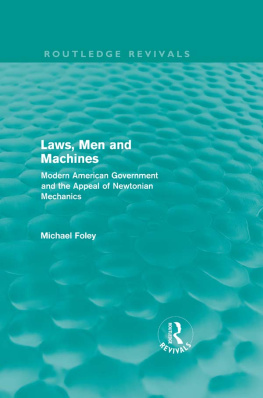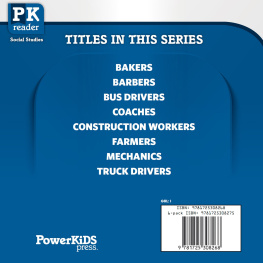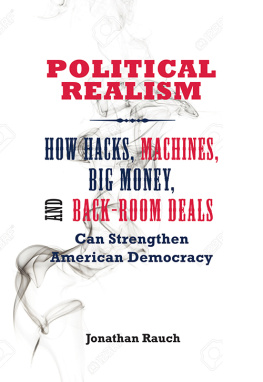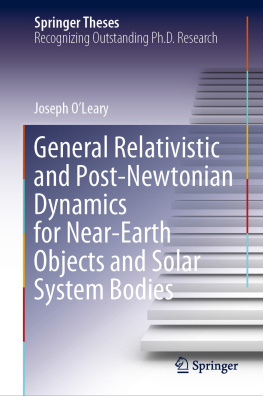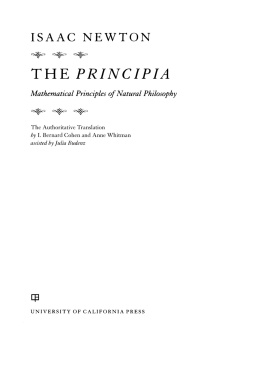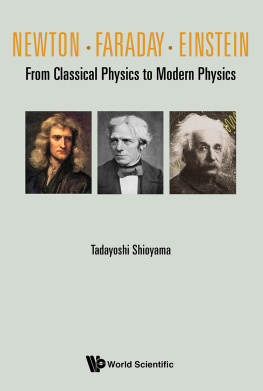Routledge Revivals
Laws, Men and Machines
First published in 1990, Laws, Men and Machines is an original interpretation of the lasting influence that Newtonian mechanics has had on the design and operation of the American political system. The author argues that it is this mechanistic tradition that now instinctively shapes the way we conceive of, analyse, and evaluate American politics, and that the Newtonian conception of the world still finds expression in the checks and balances of the American system.
Michael Foley's book is marvellous A serious exploration, careful, and controlled, of a seminal idea in American politicsProfessor Aaron Wildavsky
Laws, Men and Machines
Modern American Government and the Appeal of Newtonian Mechanics
Michael Foley
First published in 1990
by Routledge
This edition first published in 2011 by Routledge
2 Park Square, Milton Park, Abingdon, Oxon, OX14 4RN
Simultaneously published in the USA and Canada
by Routledge
270 Madison Avenue, New York, NY 10016
Routledge is an imprint of the Taylor & Francis Group, an informa business
1990 Michael Foley
All rights reserved. No part of this book may be reprinted or reproduced or utilized in any form or by any electronic, mechanical, or other means, now known or hereafter invented, including photocopying and recording, or in any information storage or retrieval system, without permission in writing from the publishers.
Publisher's Note
The publisher has gone to great lengths to ensure the quality of this reprint but points out that some imperfections in the original copies may be apparent.
Disclaimer
The publisher has made every effort to trace copyright holders and welcomes correspondence from those they have been unable to contact.
A Library of Congress record exists under LC Control Number: 89027580
ISBN 13: 978-0-415-61664 5 (hbk)
Laws, men and machines
Laws, men and machines
Modern American government and the appeal of Newtonian mechanics
Michael Foley
First published 1990
by Routledge
11 New Fetter Lane, London EC4P 4EE
Simultaneously published in the USA and Canada
by Routledge
a division of Routledge, Chapman and Hall, Inc.
29 West 35th Street, New York, NY 10001
1990 Michael Foley
Typeset by NWL Editorial Services, Langport, Somerset
Printed and bound in Great Britain by
Billings & Sons Limited, Worcester
All rights reserved. No part of this book may be reprinted or reproduced or utilized in any form or by any electronic, mechanical, or other means, now known or hereafter invented, including photocopying and recording, or in any information storage or retrieval system, without permission in writing from the publishers.
British Library Cataloguing in Publication Data
Laws, men and machines: Modern American government and the appeal of Newtonian mechanics.
1. United States. Politics. Influence of science, history
I. Title
320.973
ISBN 0415042739
Library of Congress Cataloging in Publication Data Applied for
This work had a long period of gestation during which I was repeatedly led to ruminate upon the extraordinary wealth of mechanical references in American politics. I must, therefore, thank all those who were patient enough to listen to my speculations and to allow me to formulate thoughts on the wing. I am especially indebted to my past and present students, who could always be relied upon to make the sort of innocent, but penetrating, remarks that would topple towers of previously impregnable argument.
I must also pay tribute to those who provided me with more structured appraisals and with the benefit of their opinions and advice. In addition to one anonymous referee, who helped me to tighten the analysis, I am especially indebted to Professor Aaron Wildavsky of the University of California, Berkeley and to Dr John Zvesper of the University of East Anglia. My gratitude also goes to Professor Anthony king of th University of Essex, who provided encouragement and practical help at a strategic point in the work's passage into print.
It is one thing to produce a work that is publishable; it is quite another to make it into a published work. For that I have to thank Ray Offord and Robert Tarling, but most of all my thanks go to Routledge's social science editor, Alan Jarvis. Without his efforts, I can honestly say that this book would not have been brought into existence. Technical support came in the form of Susan Blair who typed the footnotes, Doreen Hamer who typed innumerable letters, and my wife, Frances, who produced the index. Personal support and encouragement was, of course, provided by my family who ensured that Newtonian mechanics did not turn me into an automaton!
MF
University of Wales, Aberystwyth
One of the most enduring, yet least well understood, characterizations of American society is that it is mechanistic in nature. This reputation is not derived simply from the fact that so many of America's great bequests to the world have been new mechanical devices (e.g. telephone, computer) or new production techniques (e.g. assembly line, automation, mechanized agricultural production). It is rather that America is believed to have been so affected by the forms and purposes of mechanical processes that they have come to represent the principal features of American life. As a result, the United States is conventionally described as being the culture of machine living Accordingly, American society has often been either applauded or decried on the basis of whether the observer either condones a mechanized society as being dynamic, progressive, and emancipated or deplores it as being rootless, aimless, divisive, and spiritually arid. In both respects, the actual existence of a highly mechanistic society is assumed as a fact of American life.
The United States is probably not dissimilar to any of the other Western industrial states in this respect. The sheer scale of its technological capacity gives it a prominence within the community of advanced industrialized societies, but it can be argued that this particular distinction is one of degree and not of kind. What does differentiate the United States substantively from comparable societies, however, is the extent to which mechanistic concepts and values are believed to have penetrated society and to have become established as traditional criteria of perception and normative assessment. This peculiarly American trait, which was no mere adjunct to the industrial revolution but which preceded the process of industrialization, is probably given its most emphatic expression in the way that Americans tend to associate the principles of mechanical energy with the design and workings of their political system. Mechanical terms of reference are commonly employed to define the framework and to characterize the operation of the governmental system of institutions and powers. For example, the institutions are commonly seen as constituent units that move in relation to one another in accordance with a stated order of mechanical sequence; they are assumed to check and to balance each other as they proceed in motion; and they are portrayed as accommodating stress through such mathematically precise formulae as a two-thirds majority for a veto override in Congress and a three-quarters majority of states for a constitutional amendment. The analogy to a machine is further strengthened by the many references that are made concerning the purpose underlying the constitution's design. It is a widely acknowledged assertion that the Founding Fathers' objective was geared towards producing a multiplicity of parts operating with and against one another at different levels and at different times deliberately, in order to generate a framework of continuous material interaction. The purpose of the constitution, therefore, was not merely physically dependent upon institutional dynamics, but was in essence defined by them as well. While the institutions exist to perform certain specific functions, their collective role is commonly concluded to be the provision of a system of indigenous forces that serve to regulate the constituent structures and, thereby, to produce an autonomous form of control for the system as a whole.

